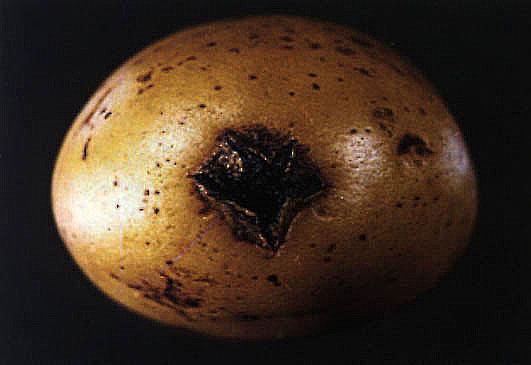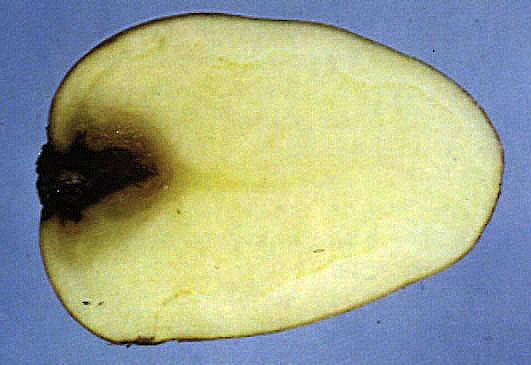Pectobacterium carotovourum
Knölsymptomen utgörs av mer eller mindre välutvecklade, mörkfärgade bakterierötor, vanligen utgående från naveländen. Den mörkare delen av rötan omges ofta av en gulbrun, geléartad zon. I denna zon syns tunna, mörkbruna trådar. Lukten är frän och knölen får kraftig bismak i kokt tillstånd.
I en del yttrar sig rötan enbart som en brunfärgning och är då fast och luktfri. Angreppets omfattning är beroende av när infektionen skett- från sättning till upptagning- samt växtplatsens, respektive lagringens miljöbetingelser. Svagare angrepp kan, vid goda lagringsbetingelser, avgränsas med sårbarriärer.
Rötan orsakas av bakterien Pectobacterium carotovourum. som huvudsakligen genom ytlig eller invändig utsädessmitta infekterar systematiskt via stoloner, eller via lenticeller och mekaniska skador. Sjukdomen är lika allvarlig för matpotatisodlingar som för utsädesodlingar. Kall och regning väderlek och dåligt dränerade jordar gynnar utvecklingen. Bakterien orsakar, tillsammans med andra bakterier, blötröta under lagringen.


Black leg
The symptom displayed by the tuber consists of patches of dark, more or less well-developed rot, usually spreading from the stem end. A yellow-brown jelly-like zone frequently surrounds the darker part of the rot. Thin, dark brown threads can be seen in this zone.
There is a pungent smell and the boiled tuber has a tainted flavour. In some cases the rot appears only as a brown discoloration and the tuber is then firm and without smell. The extent of the attack depends on when the infection took place – between planting and lifting – and the growing and storage conditions. If the storage conditions are good, mild attack can be contained with the help of the corky barrier.
The rot is caused by Pectobacterium carotovourum bacteria, which chiefly through external or internal seed contamination, systematically infect through stolons, surface pores, or mechanical damages. The disease is equally serious to both food potato crop and seed potato crops. Cold wet weather and badly drained drills promote its development. The bacteria, together with other bacteria, cause bacterial soft rot during storage.